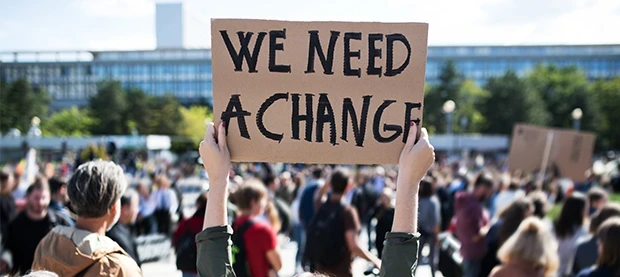This year, discussions of criminal justice reform in this country have changed a great deal. In our presidential primaries, a record number of Democratic candidates’ platforms included the importance of reform.1 The COVID-19 pandemic and recent social justice protests have brought to light ways in which our entire system, including criminal justice and law enforcement, disproportionately affects poor communities and minorities.2
The need for systemic change has been evident for some time. In December 2019, the Prison Policy Initiative, a non-profit advocacy group working to expose the harms of mass criminalization, published a report featuring 20 “winnable criminal justice reforms” for policymakers and activists to advance at the state level.3
With nationwide protests sparking debate and discussion about law enforcement policies, now is the time to start imagining what true criminal justice reform could look like, and how effective policies can:
- Reduce mass incarceration rates, particularly in communities of color
- Promote education
- Increase public safety
- Revitalize hard-hit communities
These reforms will take the work of professionals who understand the criminal justice and law enforcement systems to implement meaningful change. Here are a few of the ways we can start.
Reduce Pretrial Detention
Amendments seven, eight and 10 of the U.S. Constitution4 say:
- A person cannot be deprived of life, liberty or property without due process of law
- The accused has a right to a speedy and public trial
- The government cannot require excessive bail or fines, or inflict cruel and unusual punishments on the accused
While most everyone is given the opportunity to post bail, many people arrested and charged with crimes cannot afford bail amounts5, even with a bail bond. They could be detained for days, weeks, even months or years as they await the next steps in the criminal justice process. Further, the terms “excessive bail or fines” and “speedy trial” are subjective, even if those things are guaranteed by the Constitution. This puts pressure on accused individuals to accept plea bargains, even when not guilty, to avoid catastrophic disruption to their lives, families and jobs. It also leads to overcrowded jails, and significant costs to the states and municipalities that must detain people who can’t afford bail.
Several states are considering policies that will change pretrial detention practices, such as at-home monitoring, curfews, drug testing and reminders about court dates.6 By keeping people who have not been convicted of crime out of jails, we can significantly reduce incarceration rates and costs to house inmates.
Reforming Sentencing Practices and Mandatory Minimum Sentencing
Mandatory minimum sentences have been part of the American criminal justice system since this country was young.7 For nearly 200 years, they were applied to crimes such as treason, murder and slave trafficking. In 1951, however, Congress enacted more penalties, expanded its ability to impose mandatory penalties on more offenses, such as gun or drug crimes, and imposed longer minimum sentences. In the last 20 years alone, the number of federal mandatory sentences has doubled.8
With mandatory minimum sentencing requirements in place, a judge is unable to consider any mitigating circumstances surrounding the alleged crime. The crimes subject to mandatory minimum sentences also disproportionately affect minority communities and people of color.
A 2013 report9 highlighted a number of states with ‘safety valve’ legislation that allows judges to override mandatory minimum sentencing under certain circumstances. By creating the same safety valves in every state and at the federal level, we could significantly decrease prison populations and save millions in taxpayer dollars currently spent housing inmates for lengthy sentences.
Increase Funding for Education and Diversion Programs
Since the 2008 recession, states and the federal government have significantly cut education budgets and funding for services such as mental health and housing, and many states still have not recovered.10 Many have also reduced their rates for income taxes, which are a primary source of education funding. In addition, financial support for food stamps and Medicaid has steadily declined over the past 50 years.
By reinvesting in community programs and education, we could lower prison populations significantly. The much-repeated idea that prison planners use third-grade reading scores to project future prison populations is a myth11, but those scores can pretty accurately predict high school graduation rates.12Early investment in education, as well as educational programs for people in prison and lifelong learning programs for people who leave the prison or jail system, could significantly improve job prospects and prevent people from going to prison in the first place, and reduce recidivism rates for people who leave the system.13
Implement Effective Police Reforms
‘Defund the police’ has been a rallying cry at many of the protests for criminal justice reform in 2020. The term is often misinterpreted as its proponents’ desire to disband law enforcement entirely. Instead, the movement calls for reallocating a portion of multi-billion-dollar police budgets to other agencies and social services to help them intervene in situations that do not require the presence of a law enforcement officer.14
A review of police records in New York showed that more than 90 percent of their service calls are for non-violent crimes or other encounters, such as homelessness, disorderly conduct or medical assistance.15 By reallocating budgets to community organizations or other departments, such as deploying housing services resources rather than law enforcement to help in cases of housing insecurity, we can free up law enforcement officers to spend more time investigating and solving crimes.
Other proposed reforms include: Reforming use-of-force policies to limit the instances in which an officer is allowed to use deadly force Banning police from using chokeholds and other neck restraints16 Abolishing qualified immunity laws that protect police accused of misconduct from being held personally liable in a lawsuit17
Efforts to reform discriminatory police tactics should not be seen as attacks on law enforcement as a whole. By recognizing the value of law enforcement in appropriate situations, and finding ways to fund other services to supplement the efforts of law enforcement, we can revitalize communities. Such approaches were used in Camden, New Jersey in 2013,18 and in the wake of George Floyd’s death, Minneapolis is looking to follow suit.19
Be Part of the Force for Change.
Criminal justice reform is possible, and states including Texas have taken the lead in working to reform the system. With so much national attention on the issue, now is the time for forward-thinking policymakers to implement real changes.
Use your skills and expertise to make a real difference. Kent State offers an online Master of Arts in Criminology and Criminal Justice, with concentrations in Policing, Victimology, and Global Security. Learn more and apply today.
Sources:
- Retrieved on July 8, 2020 from themarshallproject.org/2019/10/10/2020-the-democrats-on-criminal-justice
- Retrieved on July 8, 2020 from forbes.com/sites/paologaudiano/2020/06/02/covidisparity-how-the-pandemic-is-highlighting-racial-biases-in-health-employment-and-wealth/#5d4d530f4708
- Retrieved on July 8, 2020 from static.prisonpolicy.org/reports/winnable2020.pdf
- Retrieved on July 8, 2020 from archives.gov/founding-docs/bill-of-rights-transcript
- Retrieved on July 8, 2020 from americanbar.org/groups/crsj/publications/human_rights_magazine_home/economic-justice/criminal-justice-debt-problems/
- Retrieved on July 8, 2020 from pretrial.org/get-involved/learn-more/why-we-need-pretrial-reform/
- Retrieved on July 8, 2020 from ussc.gov/sites/default/files/pdf/news/congressional-testimony-and-reports/mandatory-minimum-penalties/20111031-rtc-pdf/Chapter_02.pdf
- Retrieved on July 8, 2020 from civilrightsdocs.info/pdf/criminal-justice/Sentencing-Fact-Sheet.pdf
- Retrieved on July 8, 2020 from famm.org/wp-content/uploads/State-Safety-Valve-Report-Turning-Off-the-Spigot.pdf
- Retrieved on July 8, 2020 from cbpp.org/research/state-budget-and-tax/a-punishing-decade-for-school-funding
- Retrieved on July 8, 2020 from theatlantic.com/business/archive/2012/07/an-urban-myth-that-should-be-true/259329/
- Retrieved on July 8, 2020 from blogs.edweek.org/edweek/inside-school-research/2011/04/the_disquieting_side_effect_of.html
- Retrieved on July 8, 2020 from insidehighered.com/quicktakes/2019/01/16/report-shows-benefit-prison-education
- Retrieved on July 8, 2020 from brookings.edu/blog/fixgov/2020/06/19/what-does-defund-the-police-mean-and-does-it-have-merit/
- Retrieved on July 8, 2020 from nytimes.com/2020/06/19/upshot/unrest-police-time-violent-crime.html
- Retrieved on July 8, 2020 from npr.org/2020/06/16/877527974/how-decades-of-bans-on-police-chokeholds-have-fallen-short
- Retrieved on July 8, 2020 from law.cornell.edu/wex/qualified_immunity
- Retrieved on July 8, 2020 from nbcnews.com/news/us-news/new-jersey-city-disbanded-its-police-force-here-s-what-n1231677
- Retrieved on July 8, 2020 from time.com/5860172/minneapolis-city-council-eliminate-police-george-floyd/





